This report is part of Las Rutas del Oro Sucio [The Dirty Gold Routes], an investigative journalism project led by Red Transfronteriza de OjoPúblico in five Amazonian countries and in which SUMAÚMA is a partner
On an October afternoon, in downtown Itaituba, along the banks of the Tapajós River, nearly every store was shuttered – only the gold buyers had decided to open. The streets of the Amazonian city in the Brazilian state of Pará were reminiscent of a desert. Not just because people were baking under the region’s worst drought in 40 years, but because it was a municipal holiday, with few residents on the sidewalks. On the same avenue that holds the banks, a row of establishments shows signs, for blocks and blocks, with terms like “ouro,” “gold,” and “we buy.” Inside one of these stores that illegally purchases gold, four men wearing gold watches, gold bracelets, gold rings, and gold necklaces are fiddling with their cell phones under a ceiling fan. An oven full of junk sits next to the wall and mirrored windows block anyone outside from seeing in. A large white man stands inside. His hair is gelled back, his shirt is open to his chest: “You have metal to sell?” he asks.
On that day, the shopworkers on “gold street” were celebrating the effects of the Israel-Hamas war, which had driven gold prices up by 5%, from R$ 303 to R$ 318 per gram. In Itaituba, the shops were paying R$ 295. “When there was an explosion in Lebanon, everyone thought it was war, and in just one day gold prices rose by R$ 25 [per gram]. And then you imagine: one kilo of gold is a bar this little. You bought it in the morning and in the afternoon you made R$ 25,000,” says André, another buyer, excitedly.
But it does not take long for André’s face to drop, his wide eyes grow smaller, he becomes discouraged. The latest operations by Brazil’s environmental regulator, Ibama, and by the Chico Mendes Institute for Biodiversity Conservation to combat illegal mining around this area, along with recent Federal Police investigations into the gold trade chain, have slowed business, he says. From January to November of last year, Federal Police conducted 627 operations against illegal mining, making 439 arrests, searching 736 locations and seizing R$ 459 million (U$ 91.8 million) of assets. The combined losses to Brazil’s illegal miners were estimated at R$ 7.7 billion (U$ 1.5 billion), leaving a mood of uncertainty in the gold capital.
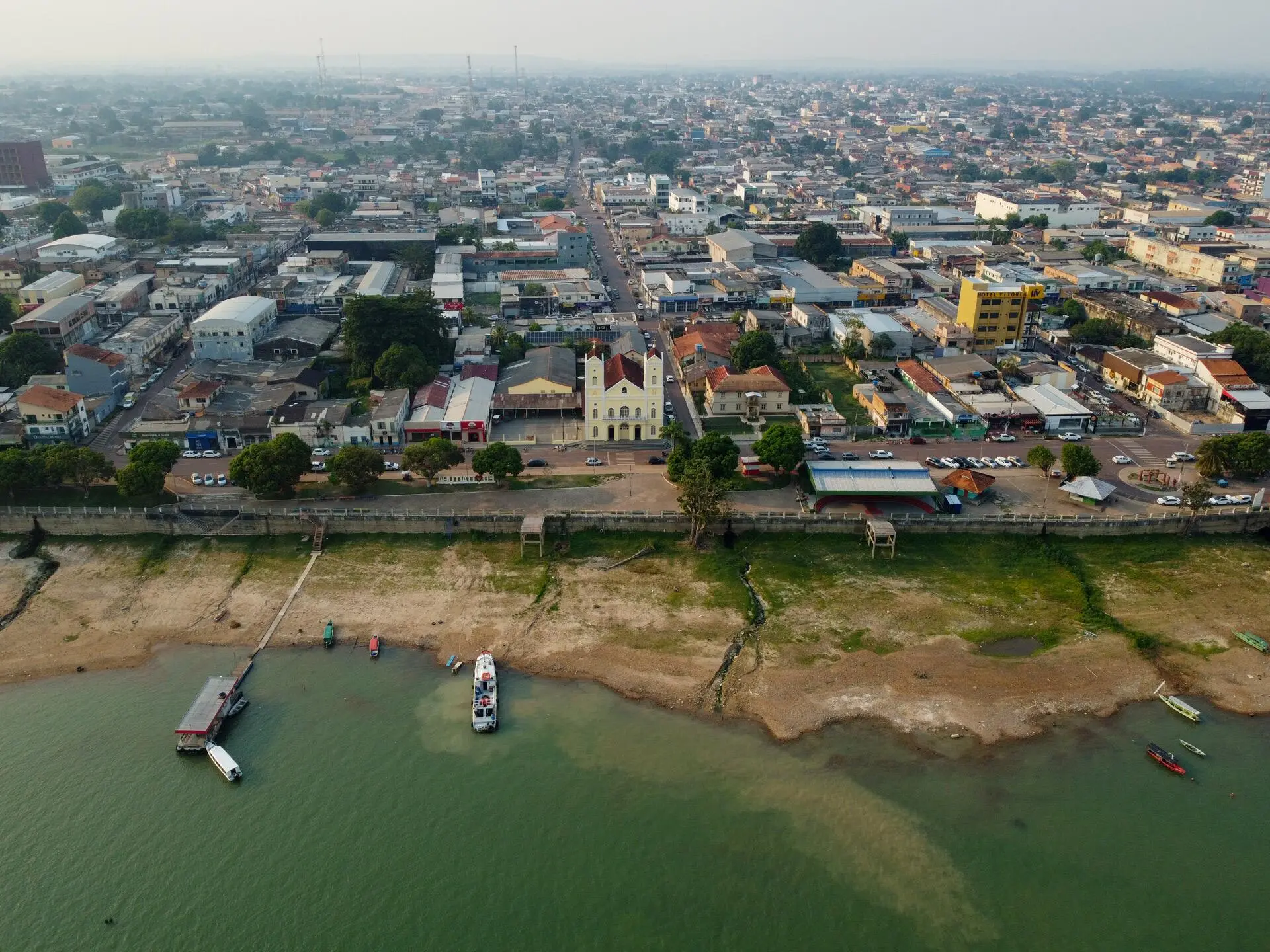
Aerial view of Itaituba, a city in the Tapajós River Valley known for its intensive gold mining activity
Sales had fallen and seizures were on the rise. Investigations by the Federal Public Prosecutor’s Office and the Federal Police froze operations at some shops. The National Mining Agency received fewer applications for Small-Scale Mining Permits – 1,585 applications were received from January 2021 to June 2022, while 850 were submitted from January 2022 to June 2023, according to the Gold Bulletin, published by the Remote Sensing Center at the Federal University of Minas Gerais, the center behind the most important sector surveys in recent years.
During the Jair Bolsonaro administration (2019-2022), when the most recent gold rush began around the Tapajós River, with support from the former president (whose father worked to mine the Serra Pelada, an enormous gaping hole that became a human “anthill” in the 1980s), illegal mining has proliferated not only in the Itaituba region, but also in other places in the Amazon. Mined areas within Indigenous territories grew by 265% from 2018 to 2022; in Conservation Units, they rose by 75% in this same period, according to a recent study by MapBiomas, a collaborative network comprised of NGOs, universities, and tech companies dedicated to socio-environmental studies. Nearly half (40.7%) of mining operations in the Amazon started after 2018, with over 50% located within Indigenous territories. The explosion in mining has been so devastating in recent years that these small-scale mining operations (both legal and illegal) take up a larger area than is used for industrial mining.

The scheme
Because small-scale mining operations are subject to less tax than big mining companies, their ore is always in high demand. “Gold from securities dealers is cheaper than gold from a mining company in Minas Gerais,” says Sergio Leitão, the Executive Director of Instituto Escolhas, one of the main non-governmental organizations dedicated to investigating the sector in Brazil. The securities dealers he is referring to are financial institutions authorized by Brazil’s Central Bank to buy and resell gold from the country’s small-scale mining operations. “Because they only pay tax on financial transactions, while for gold from mining companies they pay an additional tax on goods and services, which is much higher. It’s worth it for companies buying gold to stock up on gold from securities dealers.” In addition to the metal mined by these small-scale operations that, by law, usually operate in areas of up to 50 hectares and should use artisanal methods (a rarity in most cases), there is also industrial exploration, which in Brazil is dominated by large multinationals, like Kinross and AngloGold Ashanti. In the Tapajós region, the biggest mining companies are Britain’s Serabi Gold and Canada’s Brazauro.
Itaituba stands out in this survey, accounting for 16% of all of the holes made in the earth by small-scale and industrial miners looking for gold in Brazil, according to MapBiomas. This is no accident; the city has far and away become the largest collector of Financial Compensation for Mineral Exploration, a payment received by federal, state, and municipal governments from those extracting wealth from the ground. The city saw these payments grow by 475% from 2018 to 2021, skyrocketing from R$ 10.8 million (U$ 2.2 million) to R$ 64.3 million (U$ 12.4 million).

In the laundry-city, you can find tables set up by jewelers in the streets, stores buying gold, and even a monument to miners. Photos: Pedro Ladeira/Folhapress and Michael Dantas/SUMAÚMA
In 2022, the municipality produced 12.4 metric tons of gold – equal to approximately R$ 3.7 billion (U$ 740 million), an amount exceeding the city’s budget for that year by eight times. An analysis of data related to ore sources done by researchers at the Remote Sensing Center at the Federal University of Minas Gerais found that 5.6 metric tons were legally mined and were linked to Regular Small-Scale Mining Permits through the Financial Compensation for Mineral Exploration. Another 6.8 metric tons (55%) were considered irregular – 1.7 metric tons of which were linked on paper to mining operations that never even existed in the territory. Seen on satellite images, points on the map where gold mining should be found are instead covered by dense forest.
The researchers and prosecutors at the State Public Prosecutor’s Office of Pará began to notice a massive gold laundering scheme. Itaituba was already known for holding the most Small-Scale Mining Permits in the country (these government-issued permits give miners authorization to operate). According to the National Mining Agency, out of a total of 5,831 small-scale gold mining permits granted since 1980, 2,361 were in areas of Itaituba – of these, 1,026 are active. Not everyone, however, produces as much gold as they are allotted, a sign that these authorized mining operations around the city may be being used to legitimize gold mined illegally in other areas. The police have noticed this. Since then, Itaituba, known as the “nugget city” – its name means “small stone” in the Indigenous Tupi language – has gained a new nickname. Now the authorities call it the “gold laundering capital.”
“We have data backing this statement. First, Itaituba held nearly 50% of the country’s Small-Scale Mining Permits in 2021. The city boasts an ample availability of mining processes to launder gold – and to launder gold you need these Small-Scale Mining Permits. Second: it’s the city with the most gold trading posts operating with Central Bank authorization. In data we found in late 2021, Itaituba had 23 trading posts – the city with the second most trading posts in Pará is Novo Progresso, with five,” says researcher Rodrigo Oliveira, co-author of a study entitled Terra Rasgada [or Torn Earth, in English]. The gold trading posts are “local” branches for securities dealers. When a securities dealer (or its trading post) acquires the metal, an invoice needs to be filled out, stating where the gold was mined. Once a false source is declared, the gold becomes legalized.
“These data, on their own, would already lead us to the hypothesis that Itaituba is a laundering capital. Except that this hypothesis was already confirmed by operations carried out by the Federal Police and Federal Public Prosecutor’s Office. In many of the operations that took place in Roraima [a state with just two legal small-scale mining operations], Rondônia, Amazonas, and also in the Kayapó Indigenous Territory [where this activity is prohibited], a large flow of money from Itaituba was found,” adds the expert, who also works for the Federal Public Prosecutor’s Office. He cites a study by WWF, a non-governmental organization, which analyzed the area dedicated to mining in the municipality. The researchers found that just 8.4% of operations in this region held government authorization: this means, from a territorial aspect, over 90% of mining activities in Itaituba are developed illegally.
In addition to being the Brazilian launderer for this mineral, Itaituba is a city whose mayor, Valmir Climaco (Brazilian Democratic Movement for Pará), owns mining operations and a farm where four years ago police found an airplane with 580 kilos of cocaine and two rifles. A member of the same party as the state’s governor, Helder Barbalho, Climaco rented his family’s plane to the governor during his reelection campaign in 2022. While still in his first term, Barbalho tasked municipal governments with the job of issuing environmental licenses to small-scale mining operations. Itaituba’s mayor then began distributing authorizations to destroy the forest. Over 500 have been distributed since January 2017 – none were subjected to oversight, he admitted to the O Globo newspaper.
The mayor denies that he has benefited from illegal gold exploration in the region. “No, never [have I explored gold illegally,]” he told SUMAÚMA/OjoPúblico. “I’m an owner [of mining operations], they’re legal, but it’s stopped, three years stopped, because it’s lots of bureaucracy, so we decided to stop. And there’s almost no gold. It’s not worth it to run them, no.” Regarding the cocaine found on his farm, he says: “It was the drug traffickers who landed there without any order from us, and we reported them.”
Itaituba is a city of crumbling buildings, open sewers, precarious road signs, flooding, poverty, and one murder every eight days – yet it is filled with 4×4 trucks that cost just as much as an apartment. The city is home to a port that distributes grains produced in Brazil to the rest of the world, but its residents are forced to pay for water crossings in rickety, overcrowded fishing boats. It has a population of 123,000 people, 18,000 of whom are formally employed, according to the Brazilian Institute of Geography and Statistics – yet wherever you look you can find men in pricey cars, their bodies adorned in gold jewelry, chains hanging from their necks, gold in their teeth.
On flights to Itaituba, jewelry is part of the passenger aesthetic. Out of the window are mining operations, fallen logs, and ripped-up forest. The letters hanging from a shabby sign in the airport are a reminder that the public managers there seem to have forgotten about everything, except looking after their own finances. The bakery is named “Pão de Ouro” [Golden Bread]. The butchershop, “Boi de Ouro” [Golden Cow]. There’s a statue of a miner along the riverbank. It could very well be a statue of a backhoe.
The city draws people from different parts of Brazil looking to regularize illegally-mined metal, because of the high number of Small-Scale Mining Permits that have been authorized by the government, as shown by Federal Police and Federal Public Prosecutor Office investigations. Despite the high concentration of legal mining operations in this region of the Tapajós River, the dismantling of environmental enforcement during the Bolsonaro administration and the sector’s weak regulatory framework contaminated the country with illegalities. And worse: because all of the ore produced in Brazil is exported, the country is sending the world gold that drips with Indigenous blood.

In 2016, the Federal Police carried out an operation to shut down an illegal mining operation near the Z’oé Indigenous Territory, in Óbidos, 635 kilometers from Itaituba. Three miners were arrested. They later said in a statement that they sold the illegal gold 368 kilometers away from Itaituba in Santarém, to a trading post belonging to securities dealer Ourominas, without the shopworkers asking about the metal’s provenance, as required by law. All they asked to see were government-issued ID and taxpayer ID cards, as detailed in a Civil Public Action filed by the Federal Public Prosecutor’s Office in 2019. The investigators thought it odd. The invoices issued to the three miners were located after a court order gave them access to the company’s finances. Agents found that the Small-Scale Mining Permit listed the source of gold taken from an illegal mine in Óbidos as being from Itaituba (or rather, paperwork claimed it came from a mining operation authorized by the National Mining Agency). Eureka!
The small-scale mining operations named on official documents as the gold’s source did not produce it. It was actually produced in illegal mining operations within protected areas. Working from this discovery, the investigators looked at various receipts for gold purchases and mining processes at Ourominas. Throughout the investigation, the Federal Public Prosecutor’s Office concluded the company had been buying gold from clandestine small-scale mining operations for years. By falsifying the metal’s source on invoices, which up until then consisted of paper forms that were filled out by hand, the shop workers in Santarém were turning illegal ore into legal ore.
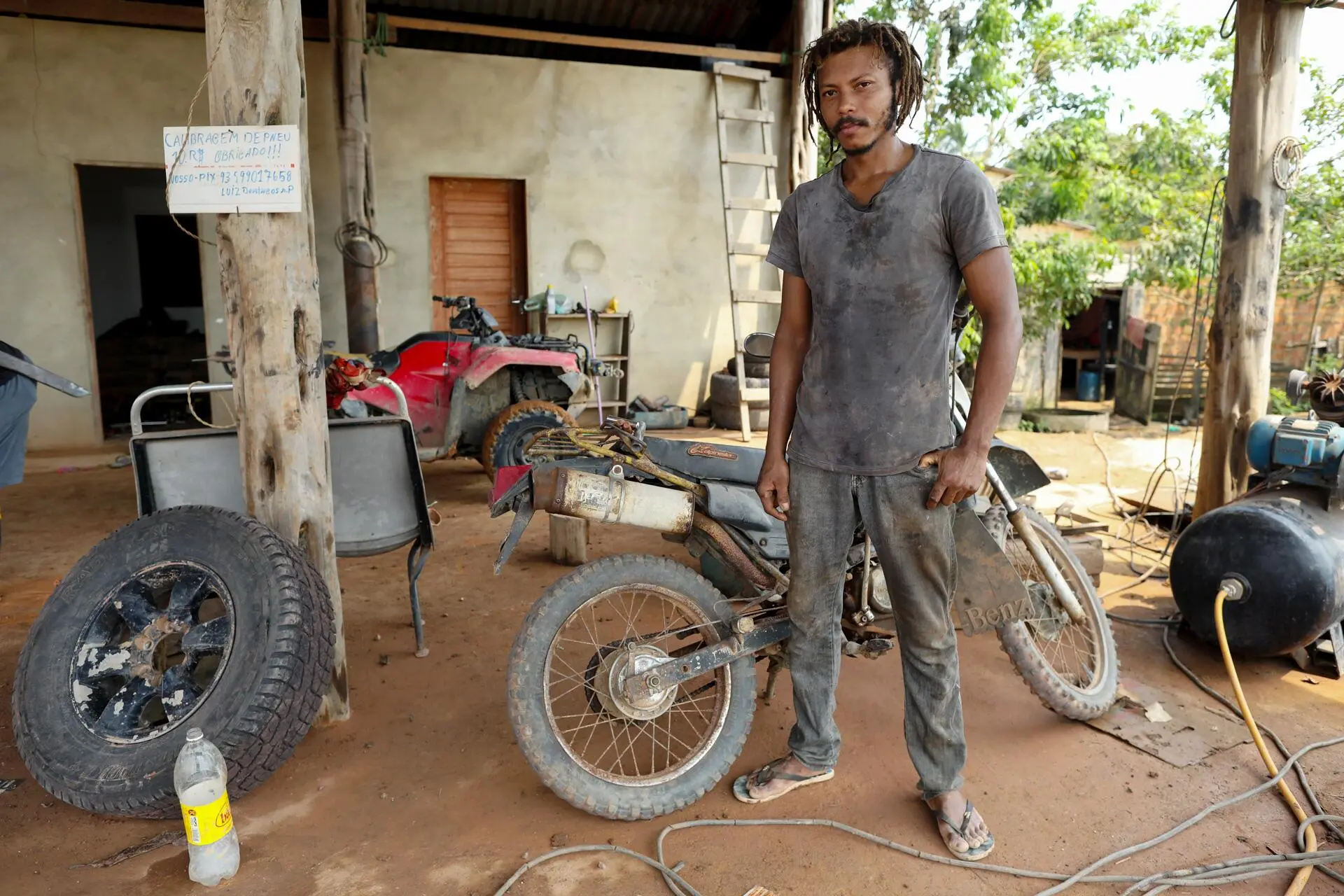
Luiz Domingos a miner and the owner of a tire repair shop at km 180 on the Trans-Amazonian Highway, between Itaituba and Jacareacanga
Based on the investigation, Bruno Manzolli and Raoni Rajão, researchers at the Federal University of Minas Gerais, worked in partnership with the Federal Public Prosecutor’s Office to replicate the Federal Police methodology on a national scale. Their Legality of Gold Production in Brazil study made clear how the industry’s executives have found a way to legalize ore ripped from the forest. The data drew attention from the scientific and academic communities, from institutions, and from the press. The Federal Police began to conduct more in-depth investigations. Bolsonaro was opening the gate to these small-scale miners. Society was opening its eyes to this. Studies later showed that 96% of Amazonian areas that are deforested for mining are located outside of the areas officially listed as the sources of gold.
The shop
Cameras are installed above the façade of the Ourominas store in Itaituba. The windows are dark. The door is always locked. You need to call an employee if you want to go in. Some establishments along the street purchase gold under the table. Ourominas is different; it is a securities dealer authorized by Brazil’s Central Bank to acquire and resell the mineral. That is why gold can only be “falsified” or “laundered” at a securities dealer, even though the storefronts are so similar.
Outside, miners from everywhere circulate. Just like the machine part vendors, water pump specialists, pump dredger mechanics, divers and airplane pilots, the miners are after gold. Lately, many have migrated to Guyana, where casserite is king, says a federal chief of police specialized in combating environmental crimes, who spoke with SUMAÚMA/OjoPúblico under the condition that he remain anonymous. He says that others come from Yanomami territory: “The miners from Itaituba are connected to the Yanomami miners. There were miners migrating from Yanomami territory to Itaituba, following the operations there. The mining operation owners do business in both states, sometimes in several other regions at the same time,” he says.
Raw gold is usually brought to Ourominas in Itaituba, according to André, a shopworker at the securities dealer. Sometimes it is brownish, mixed with sand and other minerals. Employees melt it down and pour it into iron molds where it hardens into bars weighing 50, 100 or 500 grams or 1 kilo. They next usually check the purity and weight. After that, they issue a bank payment slip for the Financial Compensation for Mineral Exploration fee, declaring the source of the gold’s removal.
According to Federal Police investigations, this is when the laundering happens. The field listing the mining operation the gold came from is falsified. Police found evidence of this method when they discovered that the Ourominas branch in Santarém was using a database of legal Small-Scale Mining Permit numbers to falsify invoices. While these permit numbers were listed as the source of the gold, it had actually been mined elsewhere. Sellers who went to the securities dealer did not have to go to the work of providing a source. The shop would fill out the form and complete the fraud, as detailed by a Public Civil Action filed by the Federal Public Prosecutor’s Office.
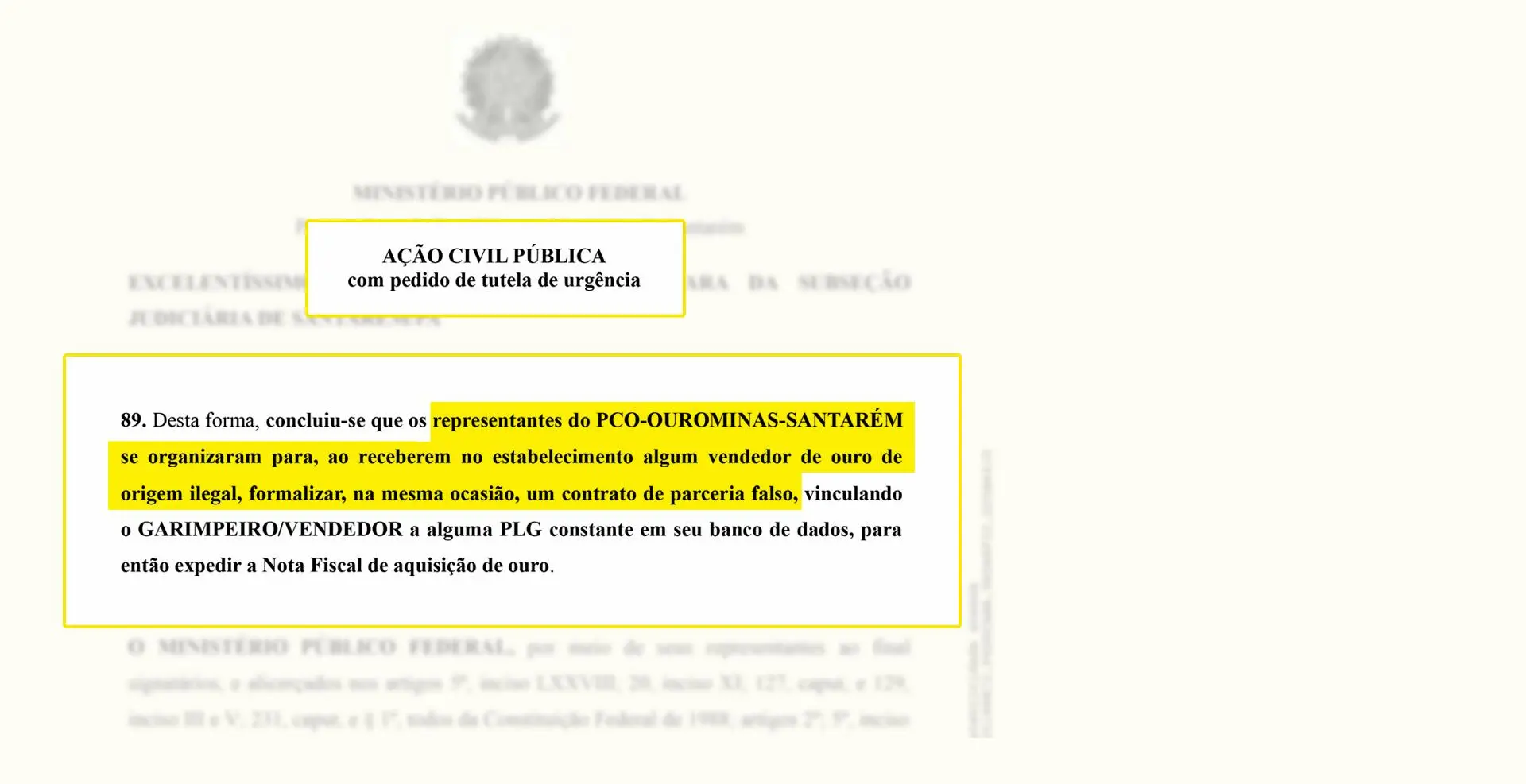
An excerpt from the public civil action filed by the Federal Public Prosecutor’s Office, showing part of the gold laundering scheme at Ourominas
“In general, the small-scale miner, when the area [Small-Scale Mining Permit] doesn’t belong to them, they’re in a cooperative. Cooperative X. Then they’re probably already registered here, their information is here…,” says André, in Itaituba, looking at his computer. “That’s how it was. Now that there’s no more good-faith…”
The Ourominas employee in Itaituba is referring to the Federal Supreme Court’s suspension of Paragraph 4 of Article 39 of Law 12.844, passed in 2013, which presumed the legality of gold acquired and the buyer’s good faith. With advances in Federal Police investigations, pressure from civil society, and the declaration of a health emergency in Yanomami Indigenous Territory following a January 2023 report by SUMAÚMA, Supreme Court Justice Gilmar Mendes suspended this paragraph of the law in April.
“Because of this article, we had a mechanism that institutionalized the laundering of resources by allowing a gold buyer to say that a purchase was made ‘in good faith’ until proved otherwise,” says researcher Rodrigo Oliveira. “How does this hurt the fight against illegal gold? They [the buyers] made this argument that they wouldn’t need to adopt any check on the gold’s source. And, because there’s a presumption of good faith, in criminal terms, it’s harder for investigative bodies to prove malice [the intentional practice of a criminal act],” he adds. Sergio Leitão, of Instituto Escolhas, adds: “In practice, this article represented an immense hurdle to punishment [of illegal gold buyers]. How do you punish someone who’s already a saint?”
Faced with the difficulty of holding buyers responsible, Gilmar Mendes also ordered the Lula administration to create “a new normative framework for oversight of the gold trade, especially in relation to verifying the legal origin of gold acquired by securities dealers,” as well as measures to make it unfeasible to purchase gold coming from Indigenous Territories and protected areas. The case has yet to receive a definitive ruling from the Supreme Court.
A few days earlier, the Federal Revenue Service had issued a normative instruction creating an electronic invoice, which took effect in August, replacing the old paper invoices that had been filled out by sellers. Now, documents that before were kept a gold buyer’s filing cabinet can be checked in real time by the authorities, and chiefs of police will no longer need to spend time on converting invoices to an electronic format. In June 2023, the government proposed a bill with new rules for trading and transporting gold. Other parliamentarians followed suit. The bills have since been stuck in the lower house, waiting to be voted on.
One solution, according to Leitão, is to require mining studies to authorize small-scale mining permits, so that the government can learn the mineral capacity of each Small-Scale Mining Plan, preventing fictitious production records, a side effect of gold laundering. “We have a good start, but there is lots to be done,” says Leitão when discussing bottlenecks in fighting illegal mining operations, such as one single taxpayer ID holding various Small-Scale Mining Permits. “Small-scale mining is no longer a rudimentary activity [its legal definition], it’s corporate. They may have one foot on the bank, but their head is on Faria Lima [Avenue],” he says referring to the street in the city of São Paulo dominated by bankers and tech companies.
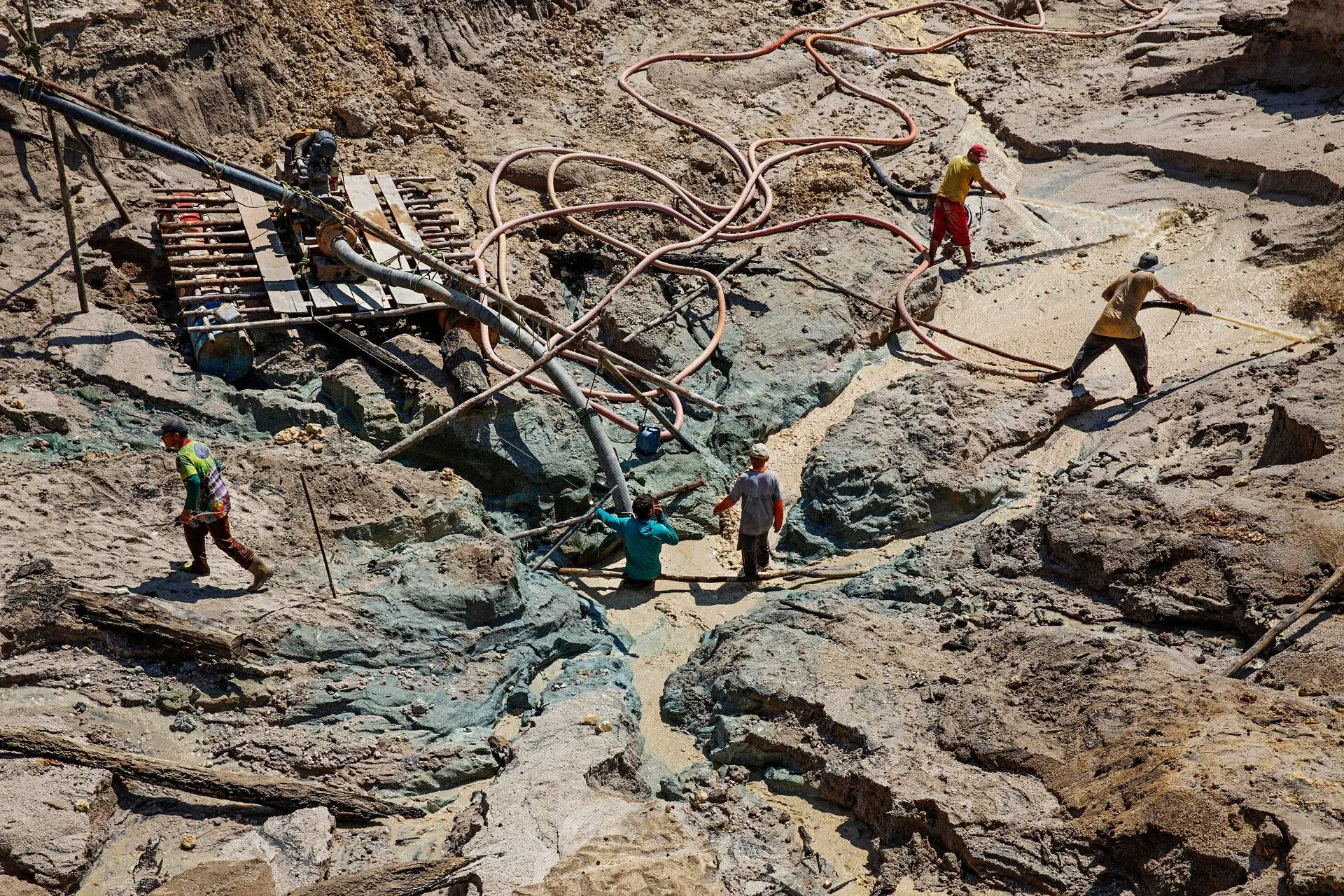
A picture taken in 2018 of illegal mining around the Rato River, a tributary of the Tapajós River. Photo: Lalo de Almeida/Folhapress
Inside of Ourominas – which, just like the Fênix and D’Gold securities dealers, was targeted by recent Federal Police investigations and is facing court battles – it was cool and calm. The air conditioning, blasting at full bore, lent a feel of Europe in autumn to the place. It is a large room with an oven in the back, similar to the ovens used in making ceramics, which exceed 1,000 degrees Celsius – except this one is used to melt gold. Eight employees were chatting. A sergeant with Pará’s Military Police, wearing the company’s uniform, was working security. At a central table, a hydrostatic analysis system, with a scale, was connected to a computer containing software that, based on Archimedes’ principle, calculated the purity of gold brought in by miners. In another corner there is a bar stocked with bottles of cachaça and whiskey, with a sign that reads: “Miners don’t pay here.” In the back, a map covering an entire wall shows clandestine landing strips in mining operations in the Tapajós region: Garimpo do Rato, Tabocal, Cuiú Cuiú, Japonês, Dá teu Jeito, Creporizão, Piranha. All there, on a custom-made map. To the right, on another wall, an old photograph, blown up and framed, shows the founders of Ourominas, Juarez de Oliveira e Silva Filho and Roselito Soares, back when they were young, standing in front of a scale and a fistful of gold.
The picture dates back to the 1980s. A time when they still did not know that their company would be among the country’s biggest buyers of illegal gold. Nor that it would own one of the few mansions in Itaituba, along the banks of the Tapajós River. They also never could have imagined that prosecutors would discover that the source of 1,080 kilos of gold purchased by Ourominas in Itaituba from 2019 to 2020 would be falsified. Or that Juarez would end up letting it slip, in a statement to the police, that the company sold illegal gold to HStern, one of the world’s largest jewelers, with nearly 70 stores, as revealed to Repórter Brasil.
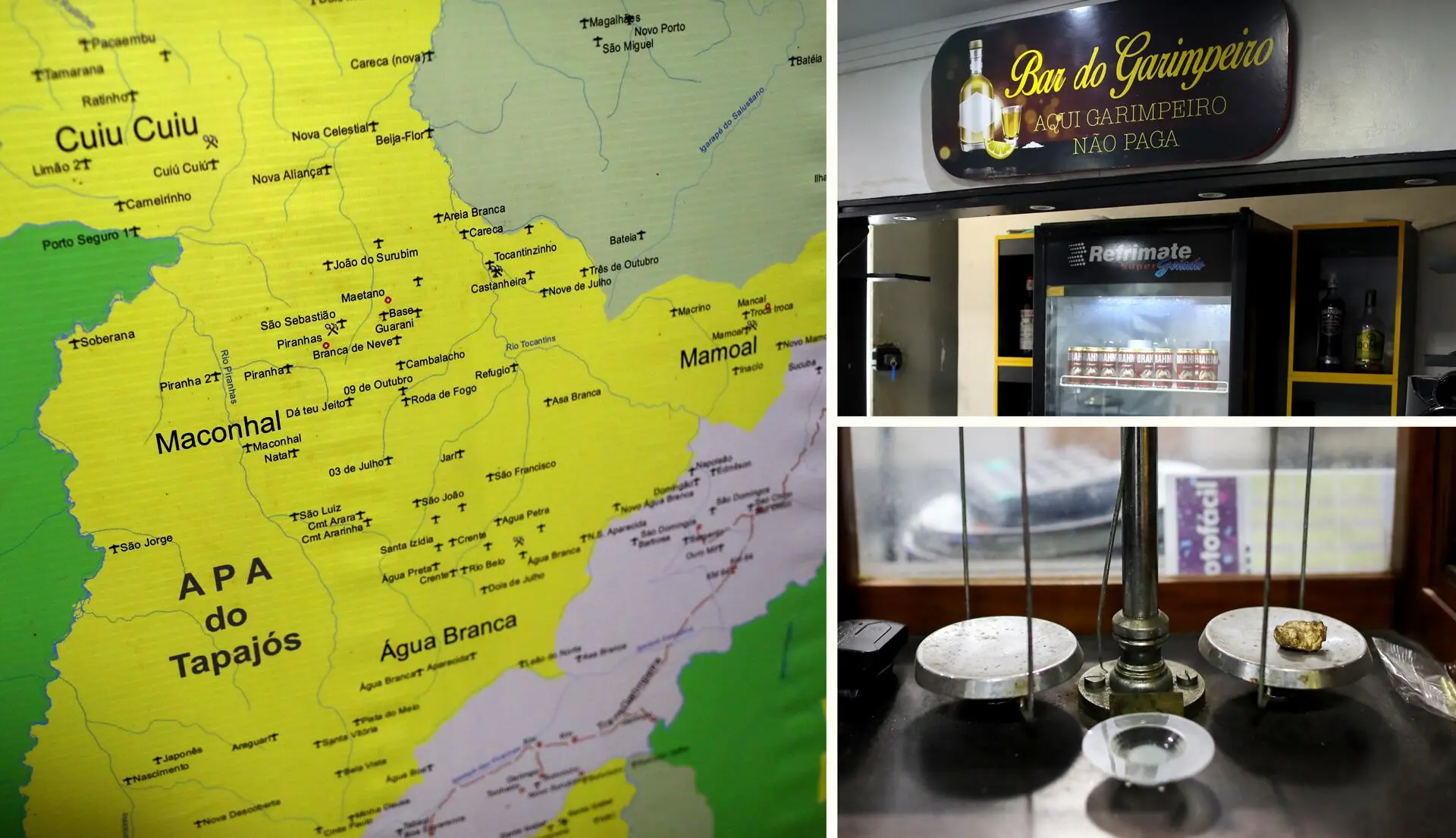
One of the gold traders in Itaituba offers miners free drinks and displays a map showing the main mining areas in the region
In 2021, the Federal Public Prosecutor’s Office asked the courts to suspend operations at Ourominas, as well as at the D’Gold and Carol securities dealers, accusing them of having sold over four metric tons of illegal gold in 2019 and 2020. The companies may have to pay R$ 10.6 billion (U$ 2.1 billion) for social and environmental damages. Yet up to now, only one securities dealer has been suspended as a result of Federal Police investigations: on November 6, the courts in Pará ruled that all operations be suspended at the Fênix securities dealer – the directors of which are friends and business partners to Valdinei Mauro de Souza, aka Nei Garimpeiro, one of Brazil’s biggest names in the non-industrial mining business and a contributor to Jair Bolsonaro’s reelection campaign.
At four in the afternoon, Ourominas employees readied to close up for the day. André usually organizes the gold bars and places them on a plane flying to São Paulo, where they fetch a better price. Right then, however, the only thing he remembered was to put the tungsten bars in the safes, since there was no gold. “It’s to trick thieves,” he says, since tungsten weighs nearly the same as gold. He sticks his hands in his pockets, the same hands that work on the computer right there on the desk, where the gold is registered.
When asked for comment by SUMAÚMA/OjoPúblico, Ourominas said it would not make any statements on facts “already dealt with” in 2016, without answering any of the questions sent. While HStern stated that “the metals and gemstones used to make jewelry come from suppliers who have an excellent reputation, who work according to regulations to correctly mine raw materials from nature.” The company had no comment on its alleged business relationship with Ourominas. D’Gold said that it “operates with strict compliance mechanisms that prevent the purchase of illegally sourced gold. (…) No operation was or is executed outside of current laws,” said a statement sent to our reporters.
The Fênix securities dealer also sent a statement to SUMAÚMA/OjoPúblico, saying that it “is still fully qualified to execute gold commercialization operations, including in the state of Pará, where it had been previously suspended, pursuant to a court ruling.” According to the company, this suspension was due to “a report that a cooperative of miners [a client of the Fênix securities dealer] were allegedly carrying out the so-called falsification of gold sources. (…) Commercialization by the cooperative using this mining license occurred in compliance with legal requirements to ensure the regularity of the first gold purchase, which did not indicate any suspicion that the cooperative could be engaging in any ‘gold source falsification’ activity,” the statement reads.
When asked for a statement through its press agent, by phone, and by e-mail, the Carol securities dealer did not respond to contacts by SUMAÚMA/OjoPúblico.
The miner
The stretch of the Trans-Amazonian Highway between Itaituba and the municipality of Jacareacanga, 390 kilometers away, is a fine line of red earth crossing a sea of forest. These woods hold a dormant volcano. It was never precisely known whether it was its unusual force that, perhaps, in a distant past, brought so much gold to the surface in the auriferous Tapajós River province or if it was actually collisions between neutron stars that dropped golden meteors on the Earth. Nevertheless, what is known is that the gold is still there, interwoven into the thick mass of life that is the Amazon Rainforest.
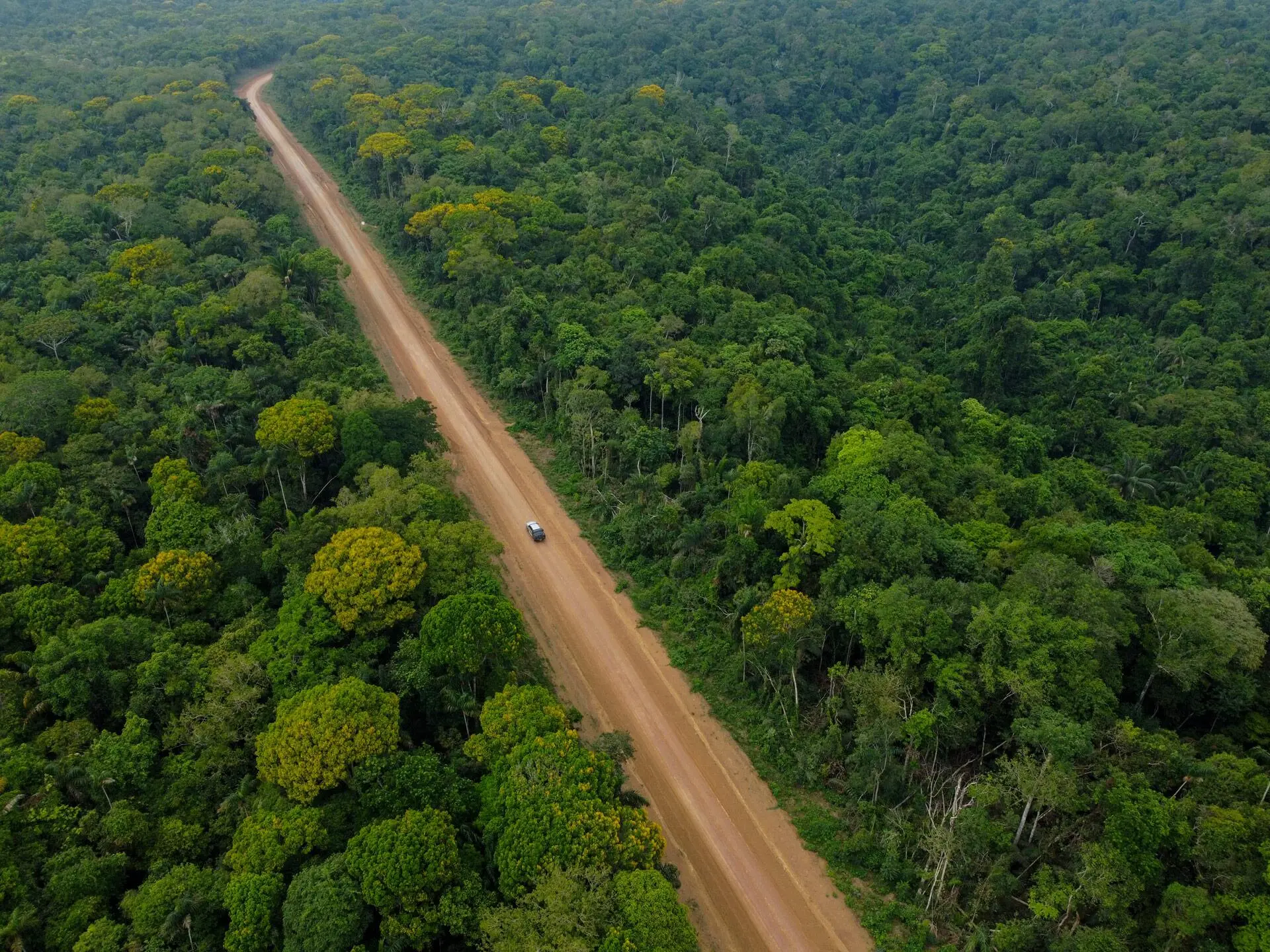
A stretch of old-growth forest along the Trans-Amazonian highway between the cities of Itaituba and Jacareacanga
Everything is huge in the Amazon. The palm trees are gigantic. The Brazil nut trees and the banana trees, monumental. In 2001, a ground sloth fossil six meters long and 13,000 years old was found in Itaituba. There are ruins from ancient civilizations. And reports of fantastic creatures. The mythical Mapinguari, Pé de Garrafa, Garrafão and Pata Redonda creatures. A ground sloth with an armadillo shell. An enormous anteater with just one eye, open on its forehead, and with a mouth on its belly. An enchanted shaman.
Two days of traveling the Trans-Amazonian Highway provided a glimpse of a group of curassows, a tortoise, two Brazilian blue dwarf beauty tarantulas, an agami heron, an agouti, a squirrel, lizards, and butterflies of every color crossing the road. Stopped in the middle of the road, a giant armadillo the size of a boar hinders the passage of trucks belonging to freight companies that, for R$ 2,000 (around U$ 400), carry up to one metric ton of goods to mining operations, invariably turning the living beings along the way into roadkill. Delivered by plane, which holds up to 500 kilos, freight costs R$ 3,000 (U$ 600). That is also why a soft drink in a bottle costs R$ 50 (U$ 10) at the mine, while a bottle of cachaça goes for no less than one gram of gold, nearly R$ 300 (U$ 60).
At kilometer 1,294, a trail left by a backhoe advances into the dark interior of the forest, the vegetation crushed by the weight of the steel. In Itaituba, the forest is feared less than the men. Miner Marinês Feitosa, 54, knows this. “I’ve seen them sell whiskey for up to R$ 5,000 [U$ 1,000] in the mine,” she says. “There are miners who look just like the devil. Just the other day, on the first [of October], this guy stuck a knife in another guy, right there,” she says, pointing to a bench outside the restaurant. “The knife went into his chest and came out of his back.”

Trucks carrying goods to miners hit and kill forest animals, like this giant armadillo on the BR-230 highway, where a bullet-riddled sign can also be found
One of the dead guy’s friends took out a gun and shot the stabber in the head. “The two bodies sat for 24 hours in front of the restaurant, on the other side of the road, where the dogs are lying now. The coroner never came to take them. The residents had the job of moving them to the city.”
The owner of the Amigo do Garimpeiro [Miner’s Friend] restaurant, along the Trans-Amazonian Highway, an old warehouse used by Tapajós River miners, Marinês is a pioneer in the region. She came in 1982, at 12 years old. “I was raised in the mine and I raised my kids in the mine.” Born in Marabá, she grew up in Itaituba and later moved to a small community of wooden houses, where she still lives today. She cleans tables, serves lunch, and rents out rooms that provide shelter to travelers, Ribeirinhos (a group of traditional forest people), cooks, truckers, mechanics, prostitutes, gunmen, foreigners, fugitives from justice… “Every type has been through here,” she says. She also has two mining operations and buys gold. “I pay 220 [per gram] at my counter,” she says. “In the city I sell for 250. I have to pay cheap, you never know if the gold will be apprehended along the way.”
Of all the ore that ever left the Tapajós River basin in the last 65 years, much of it took off from the airstrip located on the other side of the highway, 30 meters from the restaurant. Known as “km 180,” or simply “180,” it is surrounded by winding trails that lead to the wounds that mining has opened in the forest. In the city, the area is known for the quality of its metal.
“There were some eighty flights a day here,” Chico estimates, recalling what the runway was like three years ago. “Even after the pandemic, there are still a lot of flights there. Later they started to burn, burn, burn [backhoes], then there’s no one left to pull [carry cargo in planes]. There were too many flights, now there are too few. Most people are just stopped.” While they talked, two airplanes took off down the runway.
A truck carrying a backhoe goes by. A van full of mining equipment, with super-billionaire Elon Musk’s Starlink internet antenna, tied to the roof, accelerates and disappears. The dust from the road covers the leaves on the trees, the forest becomes orangish. Traffic slows, but it never stops. “Close to what used to come through it’s about 50% stopped, but we’re working,” says Luizinho, 31, who has a tire repair shop “on the 180” and a mining operation 35 kilometers away. “We’re moving bit by bit. Hidden. Just with a quatinha [an engine that pumps earth from moistened ravines to a carpet where the gold gets stuck]. There’s no way to use a backhoe any more. The people who are using them work more at night. Jet nozzles [a type of hose used to break down the ravines] are what we’re using more now.” In this method, they point a jet of water at a ravine and suck the mud with a pump.
“They burned my PC too,” says Luizinho, using the term by which the miners call the backhoes. “It belonged to my friend, I worked on it. Here in the region there practically aren’t any more [backhoes], and if another wave [of enforcement operations] comes, there will be none. The ones that were there have already gone down. It affects everything. The movement here [at the tire repair shop] was even OK, after this here… Now it’s starting to pick up again, but if another wave comes then it’ll completely stop.” At the mining operation, Luizinho works along with three underlings, some of whom are family. “They make 30% of the ravine. If we got 100 grams, it’s 30% for the three of them, 10% each.”
Marinês also lost a backhoe. This was in 2020. “I lost over two million [Brazilian reals],” she says. “They burned a four-wheeler, a camp, a freezer, a CB radio, the garage, and my PC [backhoe], with 4,500 hours, a Caterpillar, I paid 1 million and 90,000 on it. Just the welding machine I bought was 350,000.” Money she made from mining. “I’ve already found one kilo, two kilos of gold, five…” According to Instituto Escolhas, a mining operation in a lowland area [an opening on the riverbanks or in flooded areas and igarapé forests] with 18 miners, two cooks, and a backhoe brings in an estimated R$ 343,000 (U$ 68,600) per month.
The wreckage remains in the middle of the forest to this day. Now Marinês works with two of the three backhoes she had. A few kilometers away, in August 2023, a miner was killed by an agent working for Brazil’s environmental regulatory agency Ibama, causing a major uprising. Miners, along with most of the people living in the region, usually regard themselves as hard-working and they revolted against the agents of repression, saying they are “Brazilians trying to feed their families.” This is only partially true, since most of the earnings that come from the illegal actions and the forest’s sacrifice stay in the hands of big businesses, some of them located outside of Brazil, with major organized crime syndicates advancing in some areas, as was evident in the Yanomami Indigenous Territory.

Venezualan couple Thairon Fuentes and Ana María Contreras work with mining and at the Amigo do Garimpeiro (“The Miner’s Friend”) restaurant, owned by Marinês Feitosa (at right), who is also a miner
Marinês has her own outrage. “When I was born, my grandparents were already working the mines. I’m 54 years old. How many years have passed? Why now, as of two years ago, will the world end? Will the reserves run out? Will it pollute? So you mean that it didn’t used to pollute? Now it’s polluting. Oh, stop. Stop playing, my friend. You’re clowning around.”
She prefers not to notice that more gashes have begun to appear in the forest in recent years. After 2012, when the first backhoes came to the Tapajós region, the time it took to open a mining operation, which used to be one month, was shortened to one week, according to data from Instituto Escolhas. A lowland area mining operation with 21 employees and an average production of three kilos of gold per month uses 1,100 liters of diesel per day. So for each gram of gold, 11 liters of diesel go up in smoke. Three kilos of mercury are needed for each kilo of gold. One metric ton of earth has to be removed to get one gram of gold.
Multiply this by annual production and what emerges is an environmental apocalypse. According to this math, in Itaituba alone 12.4 million metric tons of earth were removed in 2022, the same weight as the amount of soybeans imported by China in May of 2023, a record month. The amount of earth torn out of the ground means that previously inexistent islands have popped up along the Tapajós River.
Marinês does not care about this. Yet while she has machines in the forest that crush the forest in seconds, she cares for a delicate garden of plants. “Don’t you have an orchid at home?” she asks a neighbor while admiring her flowers near the spot where the mining planes take off.
The city
Miner Thairon Fuentes and his wife, cook Ana Maria Contreras, left their kids in Venezuela. They have been in Brazil for less than a month. When he was 31, Thairon used to work in a small-scale mining operation, until the military under dictator Nicolás Maduro expelled anyone who was not wearing a uniform. He and his wife found work at Marinês’s restaurant. Ana Maria cooks. Thairon started working in the restaurant owner’s mining operations.
Many Latin Americans from outside of Brazil pass through there, says Marinês. Every once in a while you can hear someone in Itaituba speaking Spanish or the Creole language of Guyana. Thairon has been there. “There is a lot, a lot of Brazilian mining in Guyana,” says the Venezuelan. “Many have already worked here in the Tapajós [region].”
Maurício Torres, a professor at the Federal University of Pará (UFPA), agrees: “In Itaituba it’s normal for a miner to have a brother who is working in the Guianas. Miners get around,” explains. “In Itaituba, it’s hard to find a taxi driver who isn’t a miner.” He says that most are poor country folk, although many have hit a “bonanza,” as they say in the mining operations when someone gets rich from gold. “Today, these poor miners end up being coopted by businessmen with greater purchasing power,” says Thais Medeiros, a prosecutor with the Federal Public Prosecutor’s Office in Santarém/Itaituba.
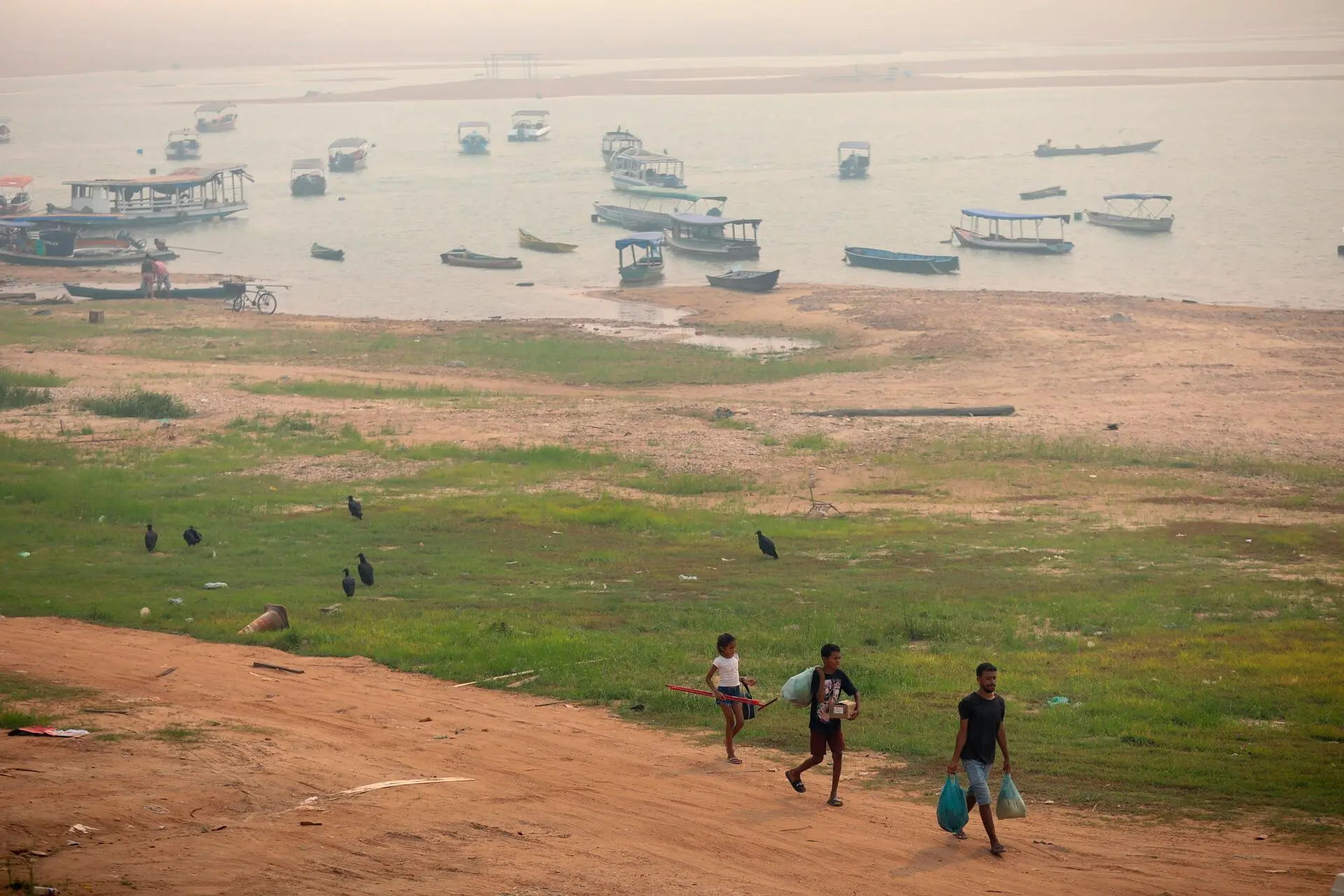
Brazil’s gold laundering city of Itaituba also suffers from the smoke coming from illegal burns também sofre com a fumaça das queimadas criminosas
In the last gold boom, during the pandemic, goldsmith Cleidson Oliveira, 40, was taking in up to R$ 11,000 (U$ 2,200) in wages each month. He is now making R$ 3,500 per month. “Before the operations, a lot more gold came in for us to work on,” he says. The same is true for dentist Hélio Soltoski, the only person with a university degree in Creporizão, a small mining town near Itaituba, who has since stopped implanting gold teeth. He has been in the region for eight years and says he has done 1,000 implants – including on patients who asked him to change out their healthy teeth for the metal’s sheen.
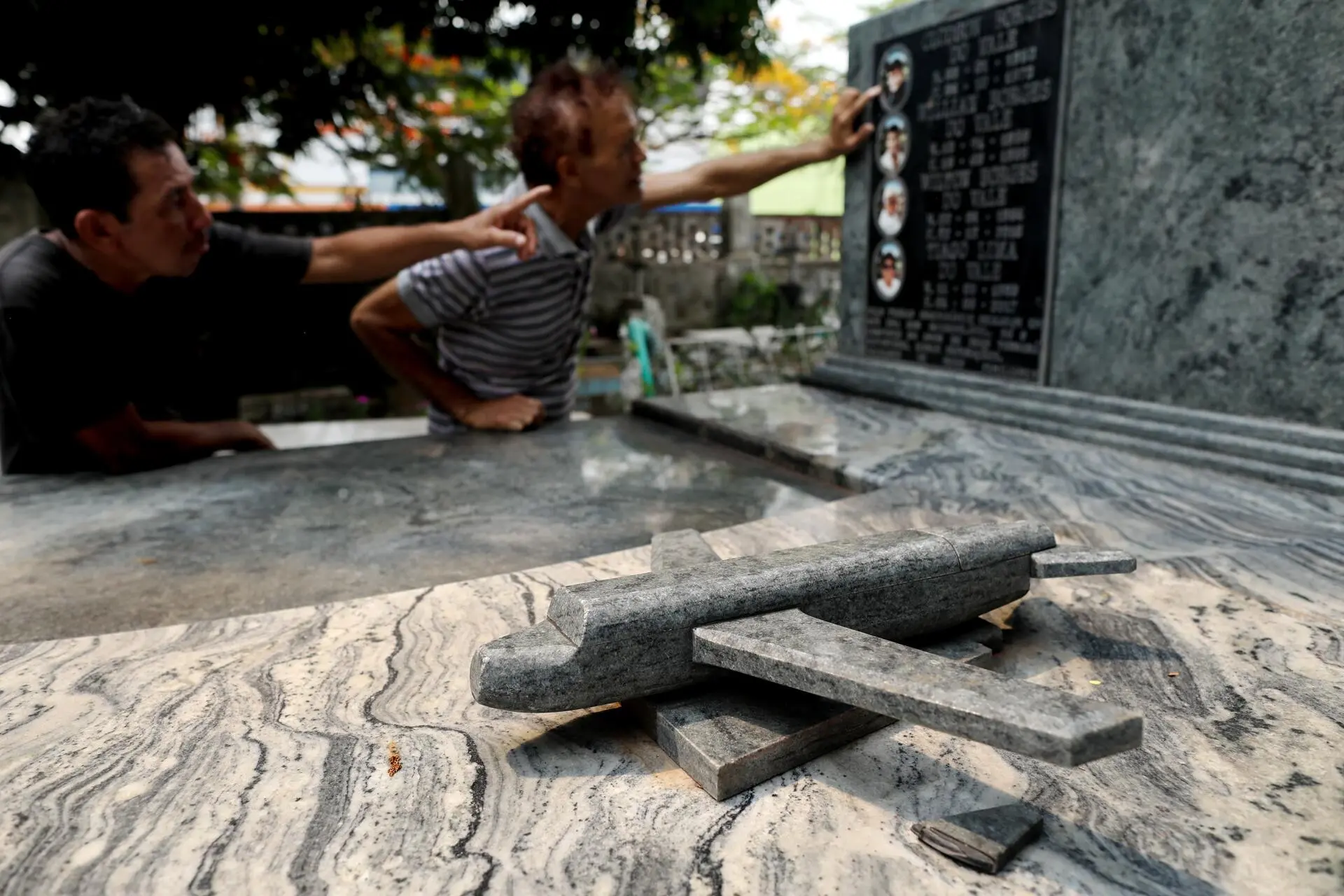
The airplanes that ensure illegal mining activity are highly valued in the region, as shown by this tomb belonging to a family of pilots who died in plane crashes
In Itaituba’s old cemetery, a gravedigger says that eight bodies are buried each day. “Some come [from the mines],” he says. Others die in the streets. In 2022, for instance, council member Odinea Peres (Progressive Party for Pará) was recorded, in a video posted to Facebook, making death threats to a blogger. “You’re going to die.” In late September, the blogger, Hernanes Alencar, also known as Zeca Tatu, was killed when he was shot in the head while riding a motorcycle.
SUMAÚMA reached out to councilmember Odinea Peres twice, by phone and by message. There was no response.
At the Municipal Chamber in Itaituba, a board in the plenary room shows sawed logs of wood, an Indigenous man, a jaguar, a cow, a rubber-tapper, a miner with his gold pan, and a mining plane taking off. A giant mix of environmental crimes and the forest. Councilmember Odinea nears a constituent during one of the sessions: “To pass at my university, I cheated a bunch, see?” Minutes later, during the vote to determine what to name the multipurpose sport court, she confesses she hates to read. “I don’t like it, I’ve never liked it.” A parliamentarian then takes the floor to announce that the Third World War is coming. The 15 council members spend their time discussing names for civil works, some of them unfinished. A normal session in the Itaituba Chamber.

A city of contrasts, in Itaituba stores selling backhoes priced at up to R$ 1 million (around US$ 200,000) sit alongside people like Juvenal Barbosa, a carter who charges R$ 5 to R$ 10 to move a load
The history
Ten thousand years ago, there were people living in what is today Itaituba. Dozens of groups of Indigenous peoples inhabited the region, the Maué, the Munduruku, and many others. This was the location of Mundurukânia, the land belonging to the then-powerful ethnic group of warriors. Later, in 1835, the Cabanagem revolution pitted the revolt and impoverishment of the Ribeirinhos against the forces of the Portuguese Empire, which ran the Grão-Pará province. The city was founded in 1856 by a military man and freemason. Rubber fever hit, then a market for jaguar and other feline furs. In the 1950s, with rubber prices low, rubber-tappers began to move into the forest looking for gold. In his book Ocekadi: Hidrelétricas, Conflitos Socioambientais e Resistência na Bacia do Tapajós [Ocekadi: Hydroelectric Plants, Socioenvironmental Conflicts, and Resistance in the Tapajós Basin], professor Maurício Torres talks about how in 1958 a rubber-tapper named Nilçon [sometimes spelled Nilson] Pinheiro found ore deposits for the first time in the region, at the mouth of the Tropas River.
In 2008, Regina Lucirene, a teacher and researcher and the founder of the Aracy Paraguassú Museum, in Itaituba, said that while Nilçon receives credit, the first person to find gold was Raimundo Ramos, a government employee who lived in Jacareacanga. They met in the city. “He [Raimundo] had found gold at the place [Tropas River]. He took an empty powdered milk can and put it inside,” the museologist says. According to her, the can was given to Nilçon Pinheiro in exchange for hammocks and supplies.
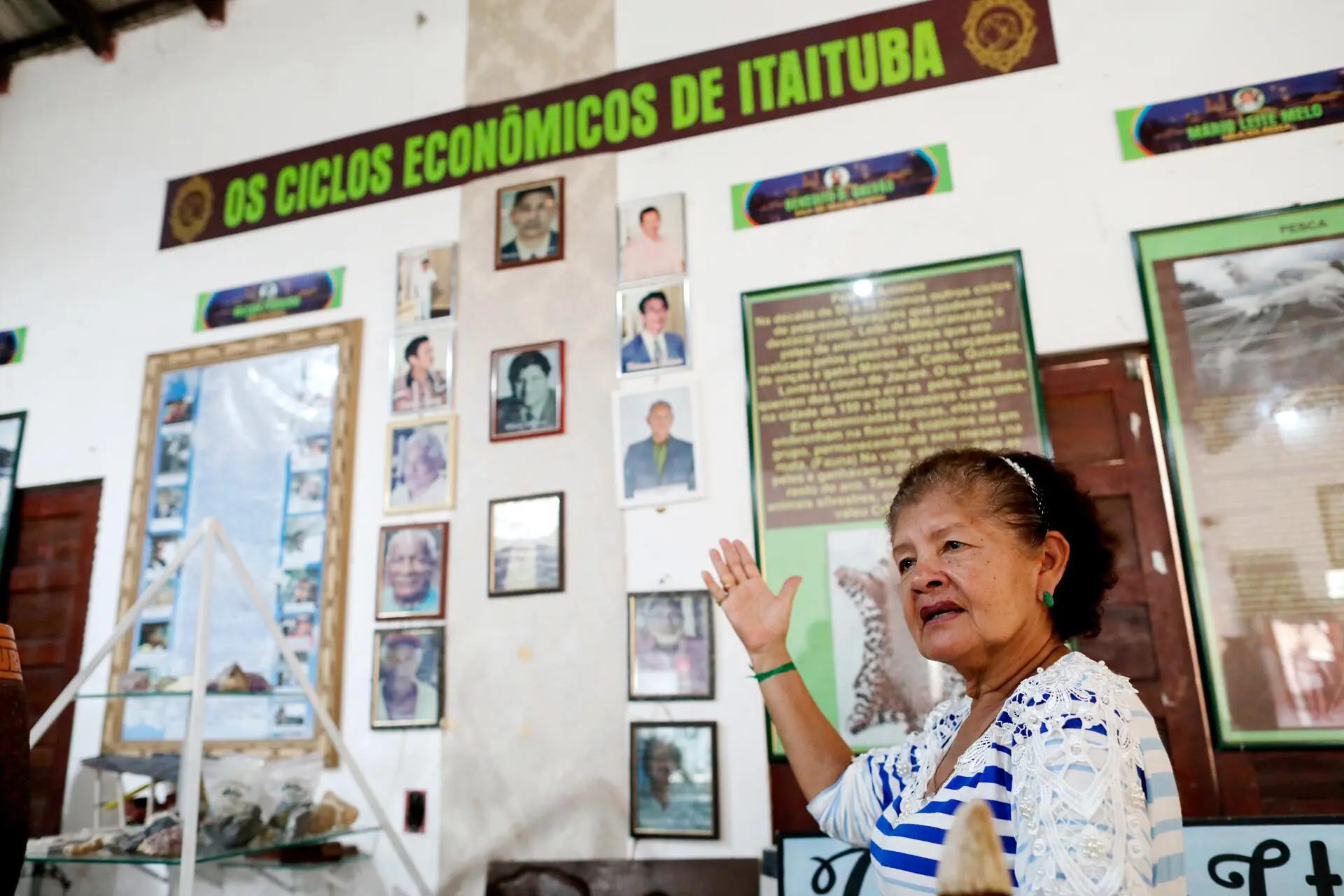
Regina Lucirene, a teacher and the founder of the Aracy Paraguassú Museum, keeps the secrets of the city’s history and the search for gold
Years later, in 1983, in an attempt to clear mining operations from Serra Pelada, the international fame of which was growing, the military government created the Mining Reserve in the Tapajós Valley – and it opened a road to the miners deep in the forest, the Trans-Miner Highway. Later, in 2006, during the first term of president Luiz Inácio Lula da Silva (Workers’ Party) and Marina Silva’s first round as environment minister, the mining reserve was turned into the Tapajós Environmental Protection Area, the Crepori National Forest, and other conservation units. The miners, however, remained there.
The Baron
Forty years later, it is Saturday night in Creporizinho. The small town lies at the end of the Trans-Miner Highway, which starts in the district of Morais Almeida, crosses the Jamanxim River, and continues along for 150 kilometers. Satellite images show the road slicing through the immense forest, the wounds opened by mining following the road. Seven trucks carrying the trunks of centuries-old trees move down the road in the span of three hours. Gold exploration never stopped around here. Nor did timber exploration. According to the Federal University of Minas Gerais, in the first semester of the year, Itaituba continued to lead gold production in the country. By June 2023, it had sold 4.8 metric tons of gold, 2.6 of which came from dubious sources.
The main road in Creporizinho is a line of houses built of wooden boards and precarious roofs, holding 300 miners, all men, along with around 20 women and girls. Nearly everyone gets drunk, whoops with laughter from moving motorcycles, and grills meat. Every establishment is a bar. There are a dozen cabarets. Each has multicolored lights and is blasting music. Dogs run underfoot. A four-wheeler carries five shirtless young men, they laugh, rocking along the pot-holed terrain. They’re all drinking. One group is snorting cocaine on a pool table, inside one of the precarious establishments. A miner is dressed up in a witch costume. There is a jukebox playing melancholy songs and heavy beats that shake the shingles. The Comando Vermelho criminal organization is here, one of the city’s federal police officers warned.
Six kilometers away, along the Trans-Miner Highway, businessman Valdinei Souza, aka Nei Garimpeiro, has had a farm with a private lake and a mining operation in his back yard for 20 years. A partner and friend to Mato Grosso’s current governor, he is regarded as a gold baron in the region. That night, an armed security guard was watching the gate while a Starlink antenna offered free internet to anyone passing along the road. Inside, the thick slice of a broad tree is used to hold the ice keeping the beer cold. “Today you get 100, 200 pilots. What’s this pilot going to do?’ he asks, complaining about the government repression of mining aircraft. “The guy’s used to making 40, 50, 70, up to 100,000 a month. He can’t fly there in that region. So he goes to the city. He has nothing to do. What happens? Crime [narcotraffic] comes in to offer work to these guys, because they’re good pilots, used to flying heavy, to flying low, in old planes, and operating on runways that are impossible to operate.”
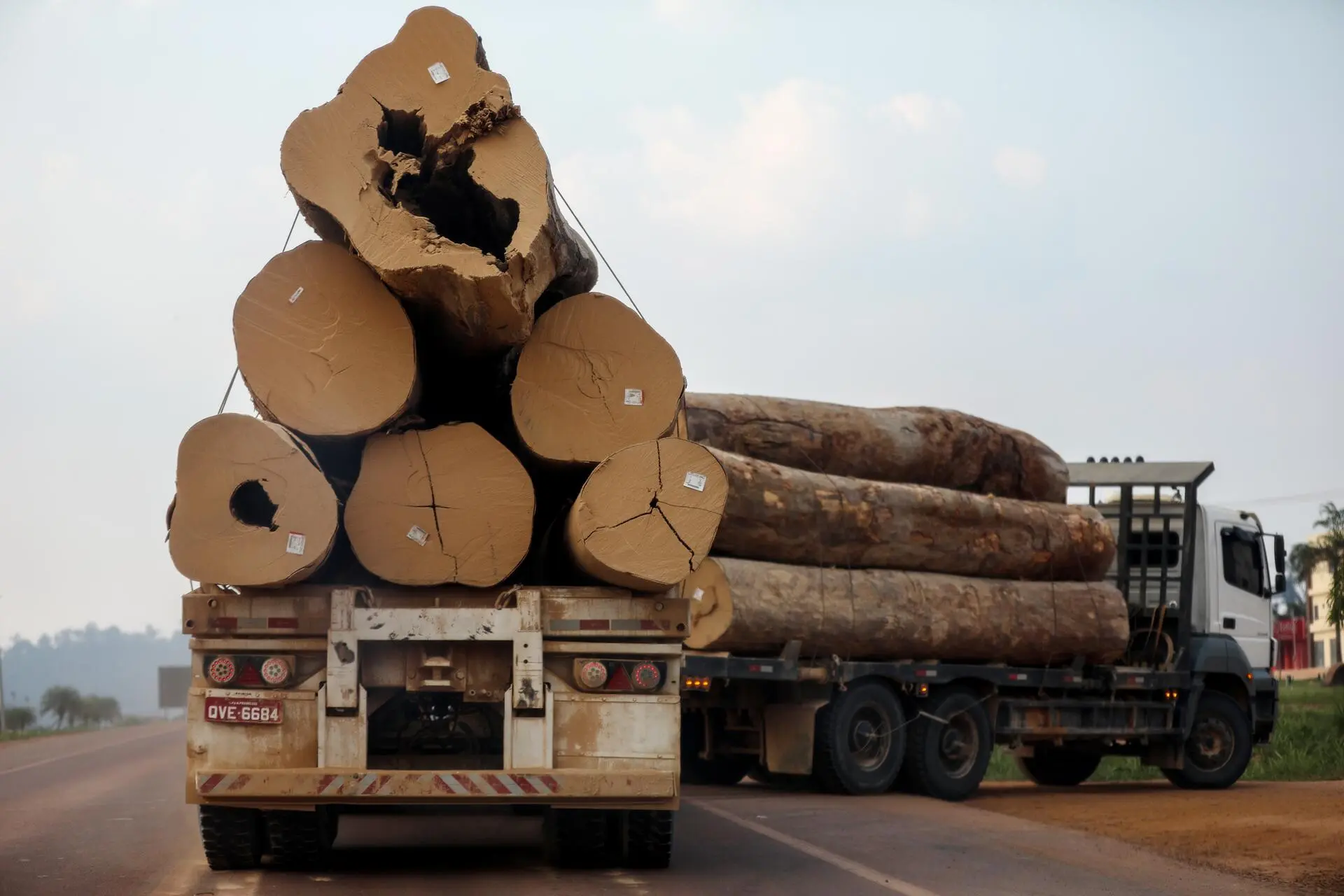
A truck loaded with logs of wood on the BR-163 highway, in the Moraes Almeida district of Itaituba
One month after speaking with SUMAÚMA/OjoPúblico, Nei Garimpeiro was targeted by a Federal Police operation because, according to the investigations, he acquired, for himself and for companies in which he is a partner, over 300 kilos of mercury from smugglers. When again asked for comment, he defended himself: “I bought mercury from a reputable company that had Ibama [Brazil’s environmental regulator] and Federal Police authorization to sell mercury. I and my companies are authorized to use mercury and make purchases from this company, we did nothing that was illegal. All of our purchases were made with invoices and payments from a transactional account to the company’s transactional account.” According to him, nearly every small-scale miner in Brazil uses mercury. “This is some 10,000 small-scale mining operations, more or less, around Brazil. Maybe even double: 99.5% use mercury without an invoice and without regularization.”
The highly toxic metal drains from the mining operations down to the river. It is absorbed by the fish. It sickens populations. And there are strong signs that it is causing deformities in Munduruku children. The miners do not usually talk about this.
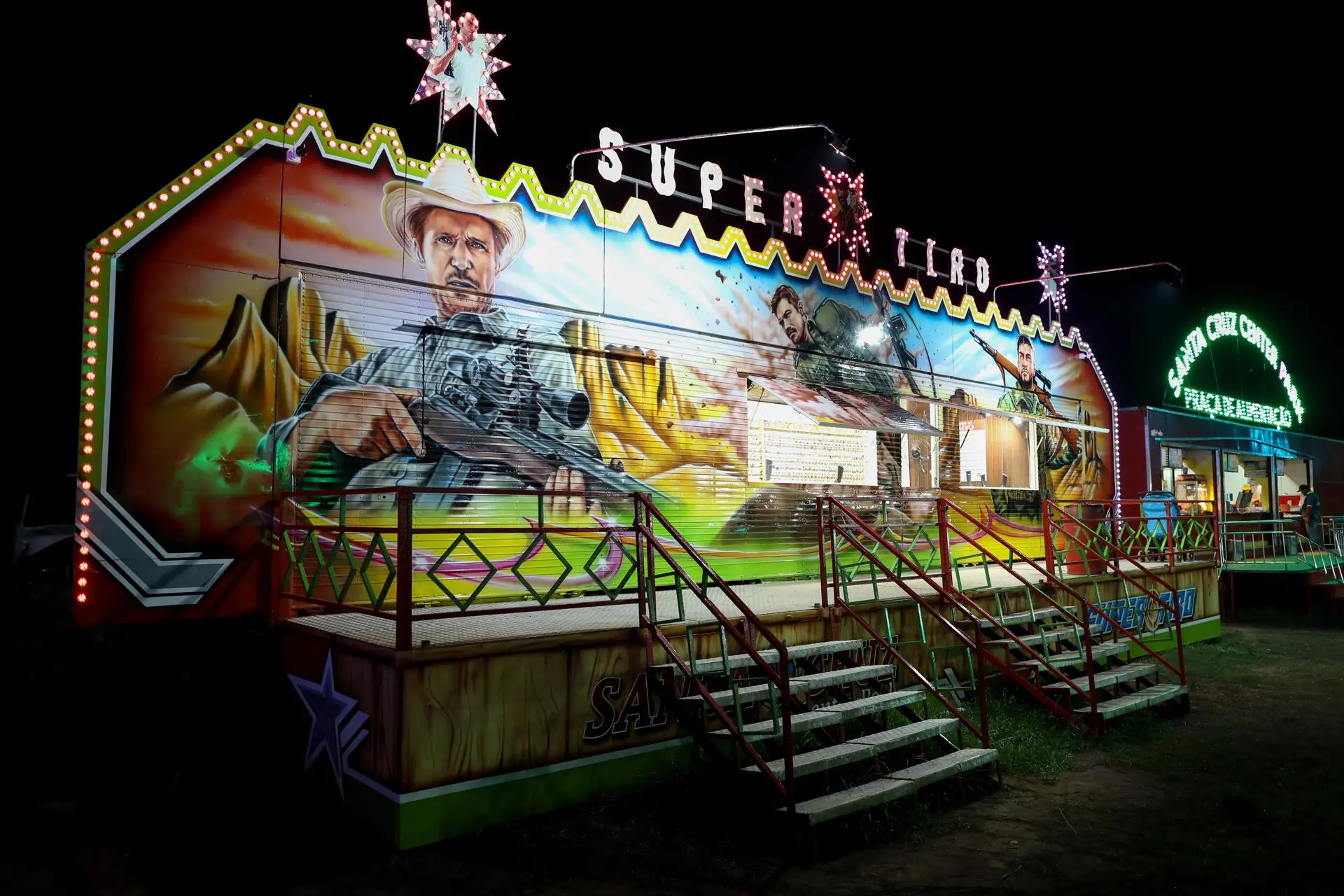
Beyond the bars an amusement park perks up the nightlife, with attractions suited to local gun-toting tastes
Editing: Ana Magalhães
Photo Editor: Lela Beltrão
Fact-checker: Plínio Lopes
Proofreader (Portuguese): Valquíria Della Pozza
Spanish translation: Julieta Sueldo Boedo
English translation: Sarah J. Johnson
Infographics: Rodolfo Almeida
Layout and finishing: Natália Chagas and Erica Saboya
Editorial workflow coordinator: Viviane Zandonadi
Editor-in-chief: Talita Bedinelli
Editorial director: Eliane Brum


